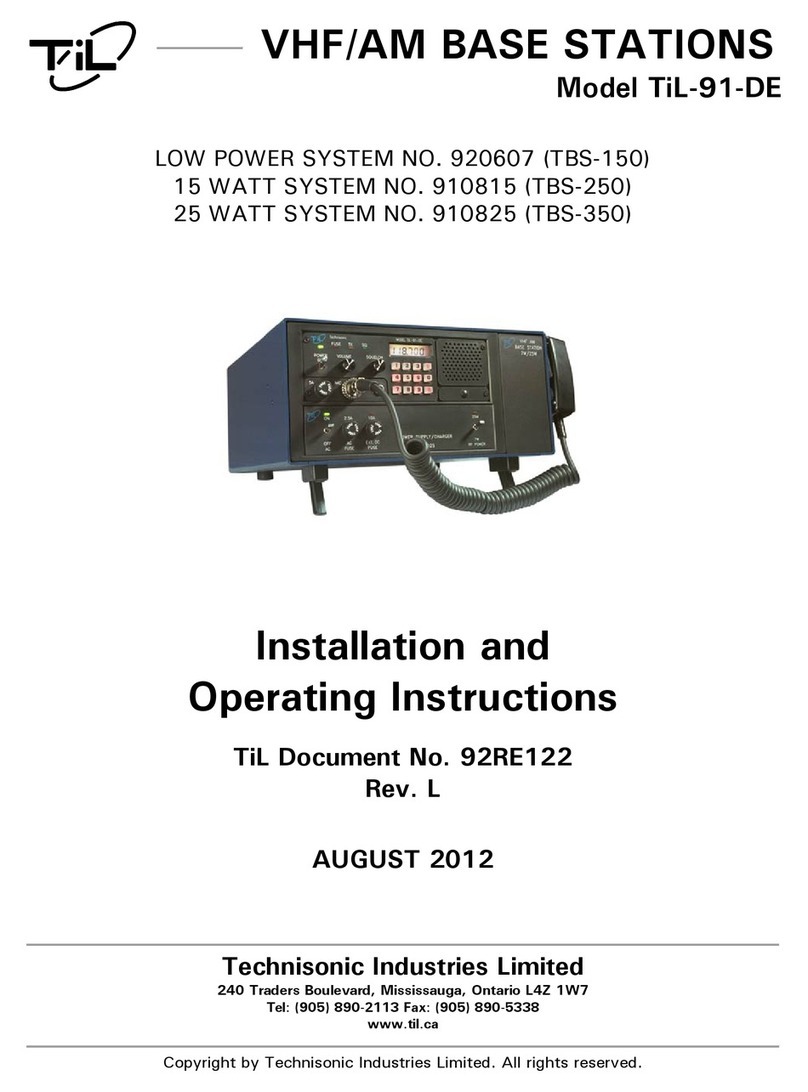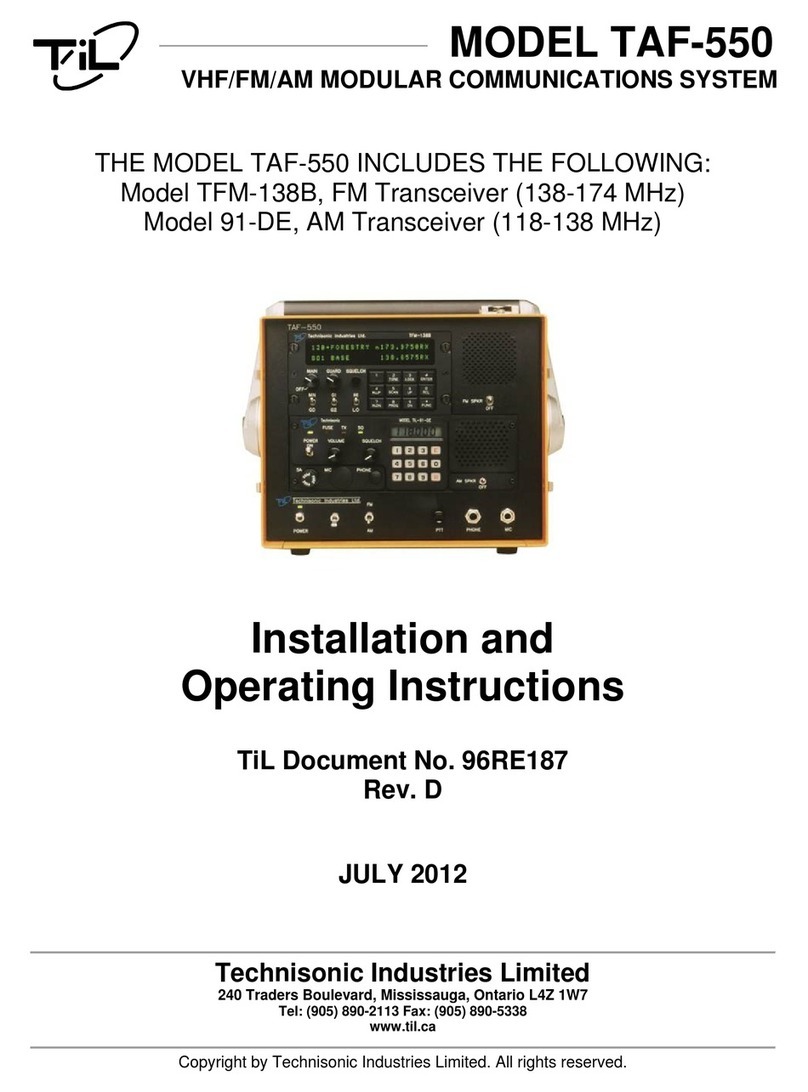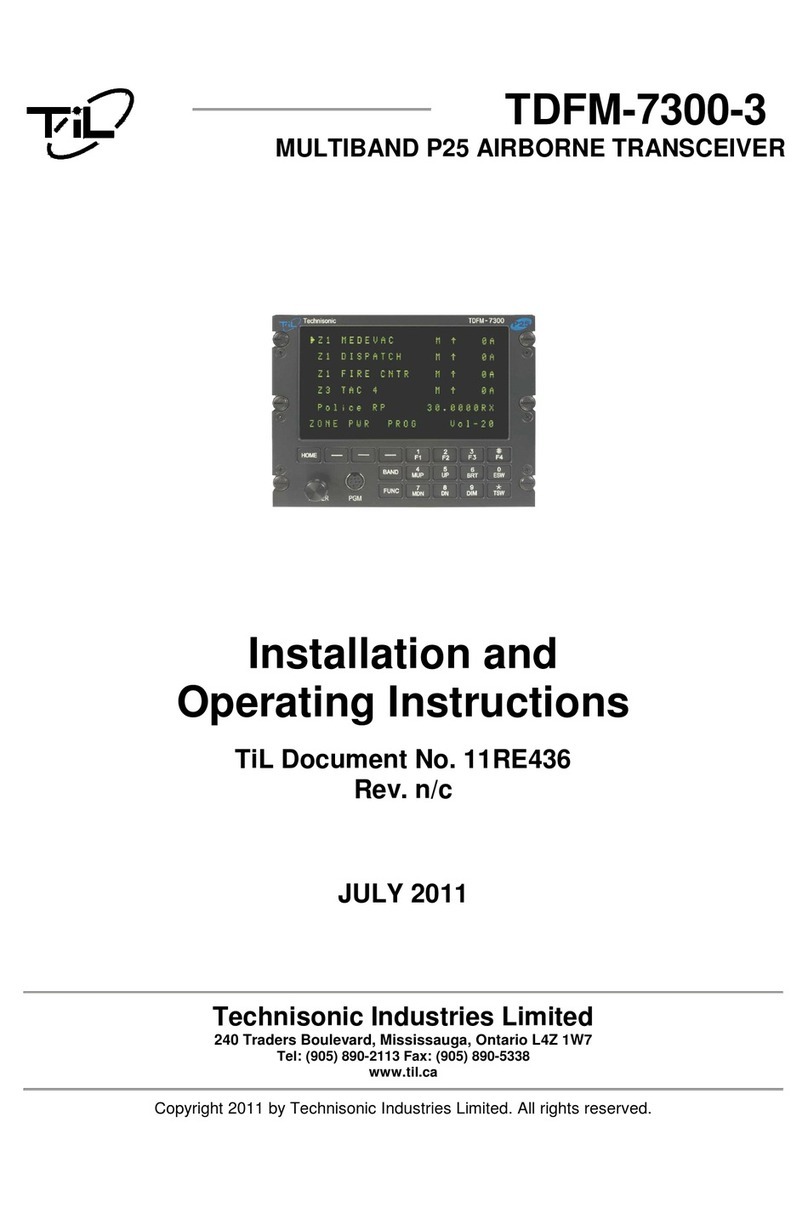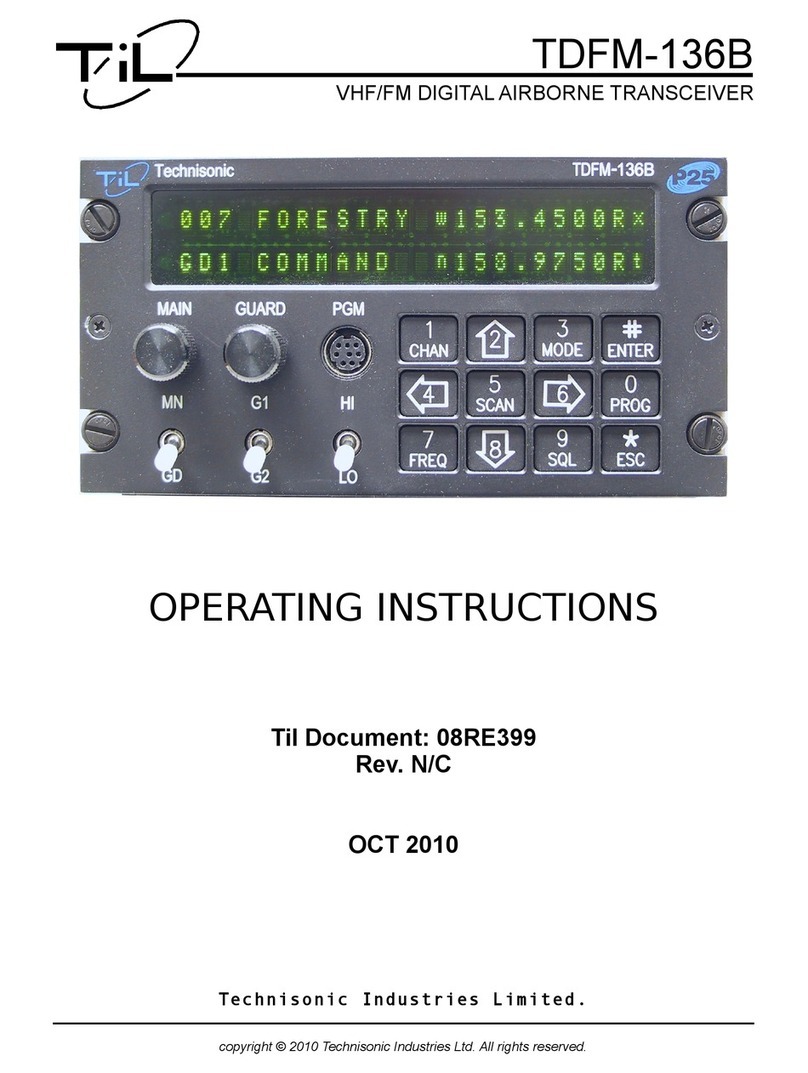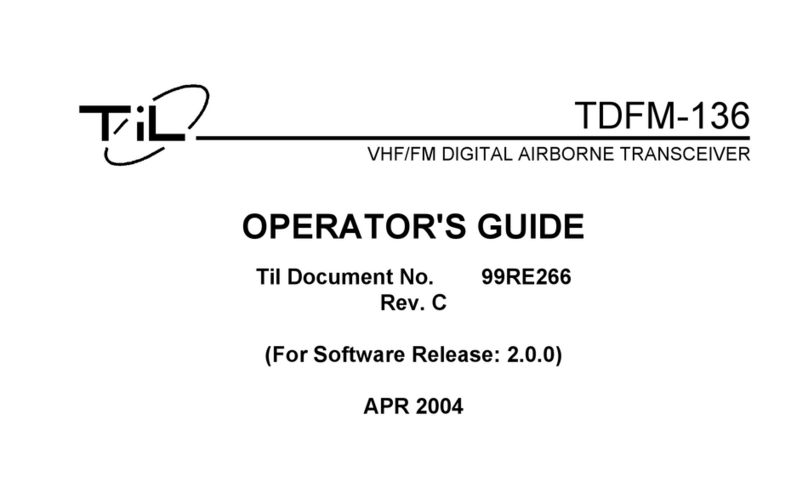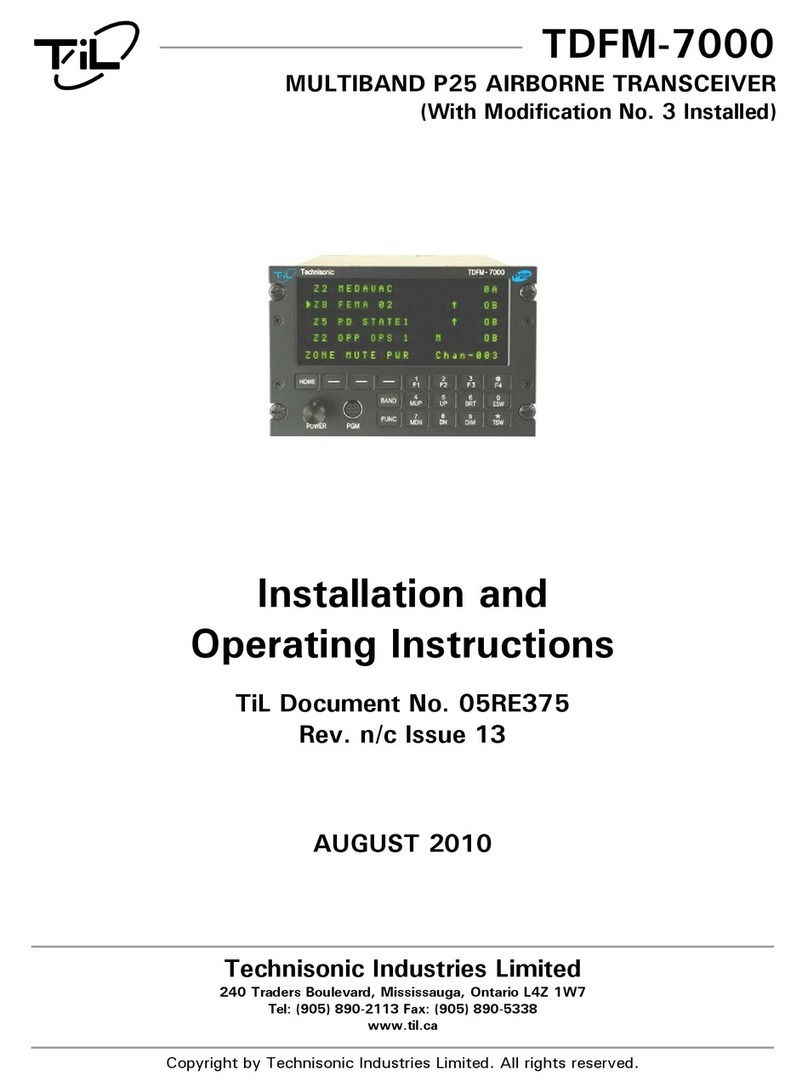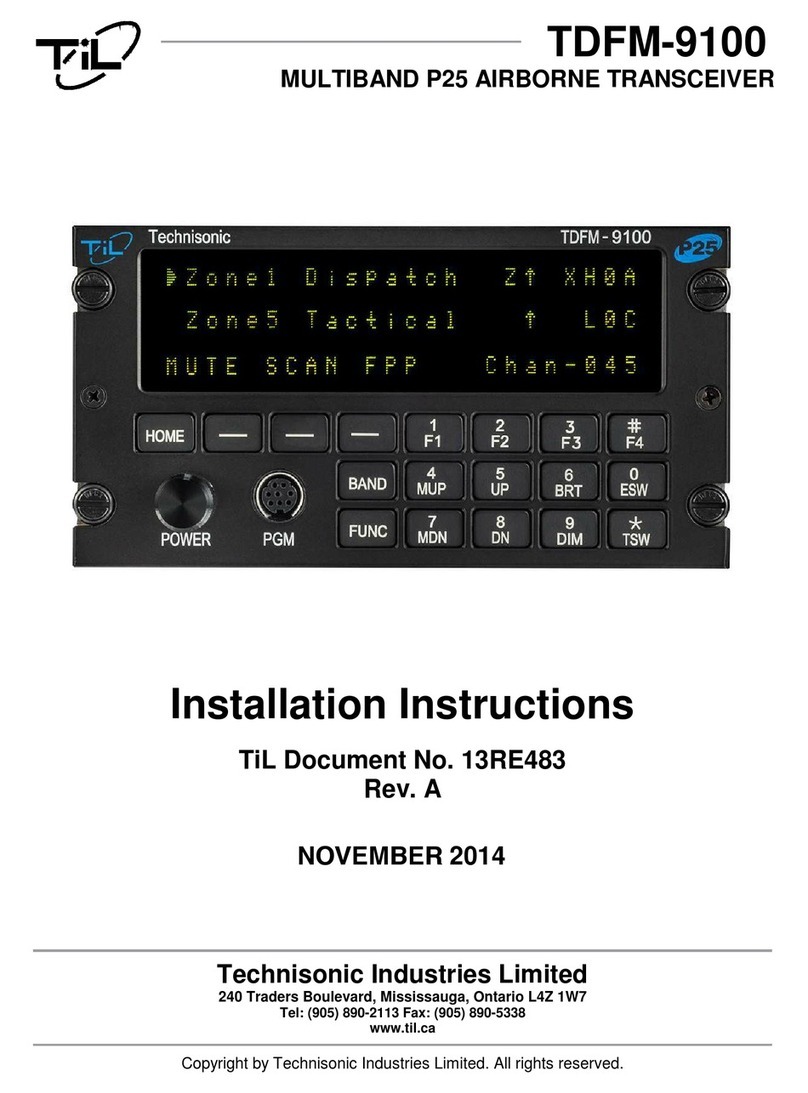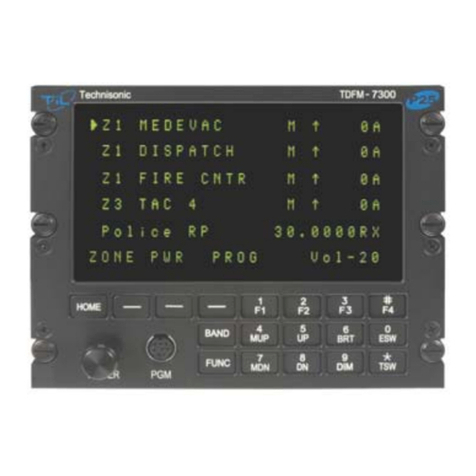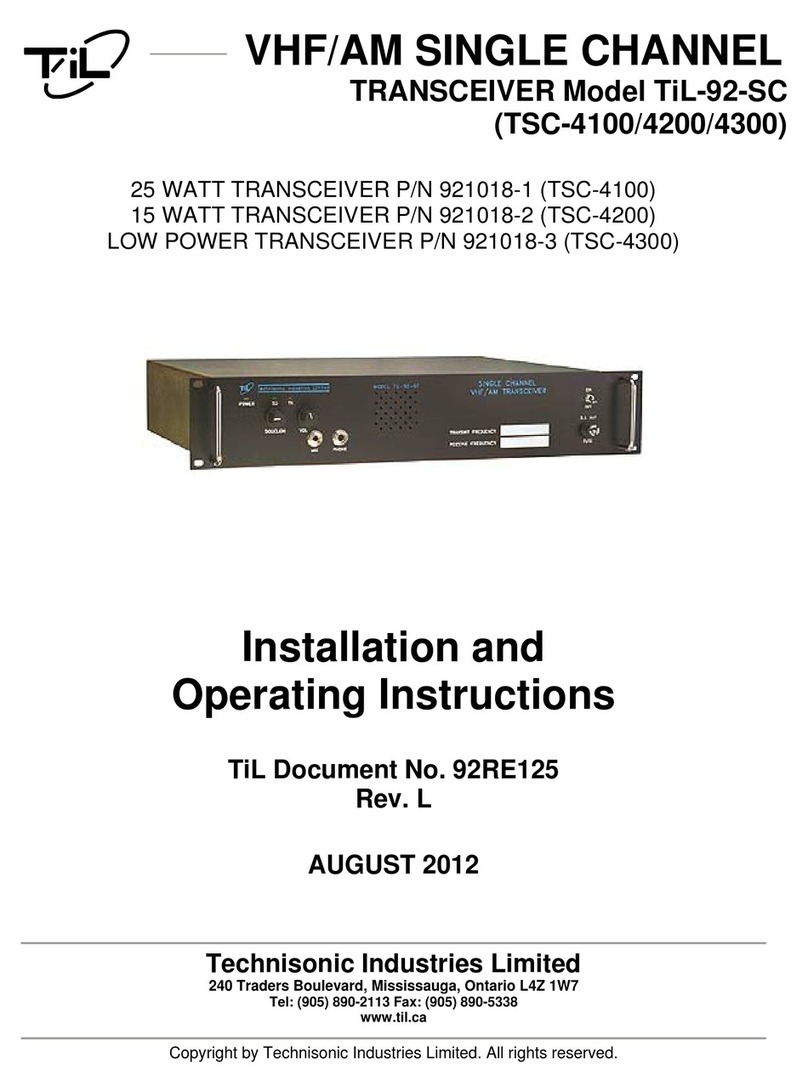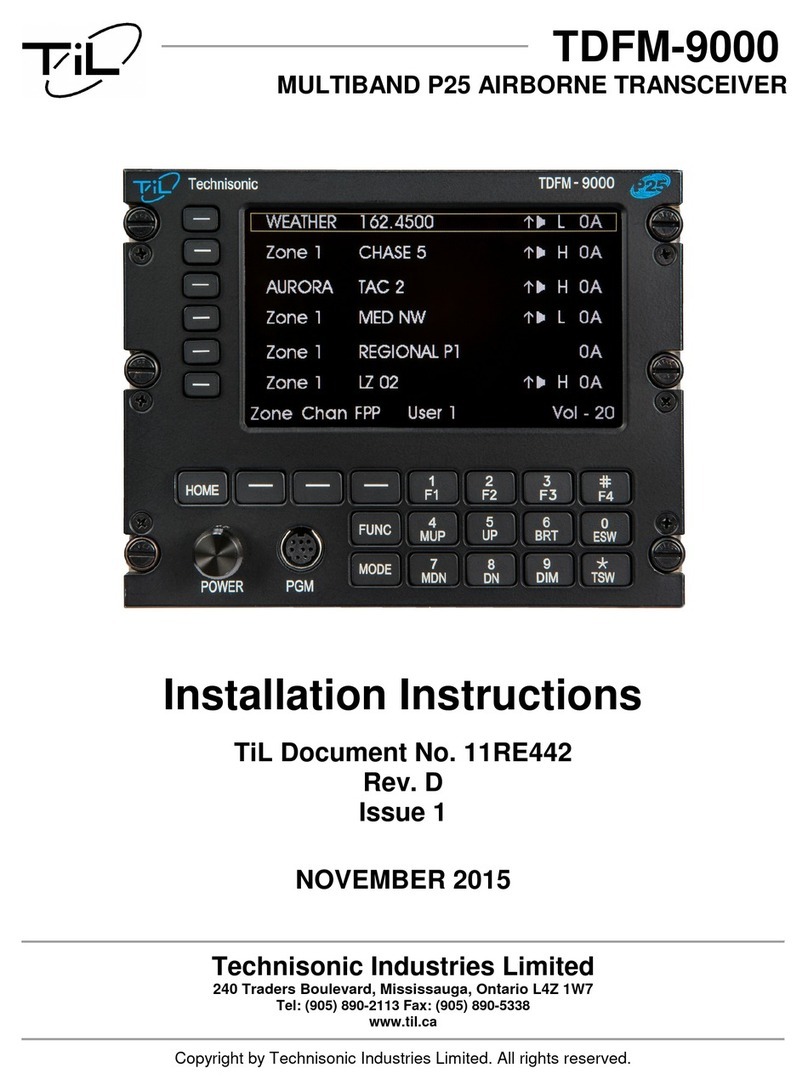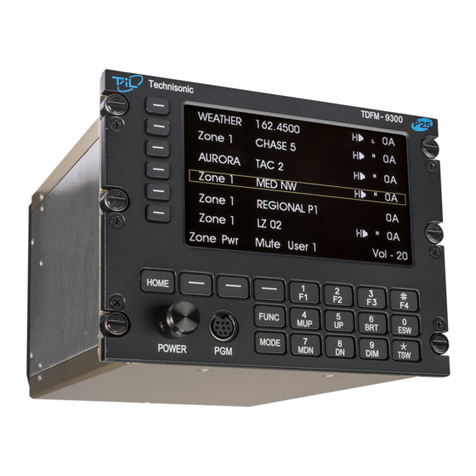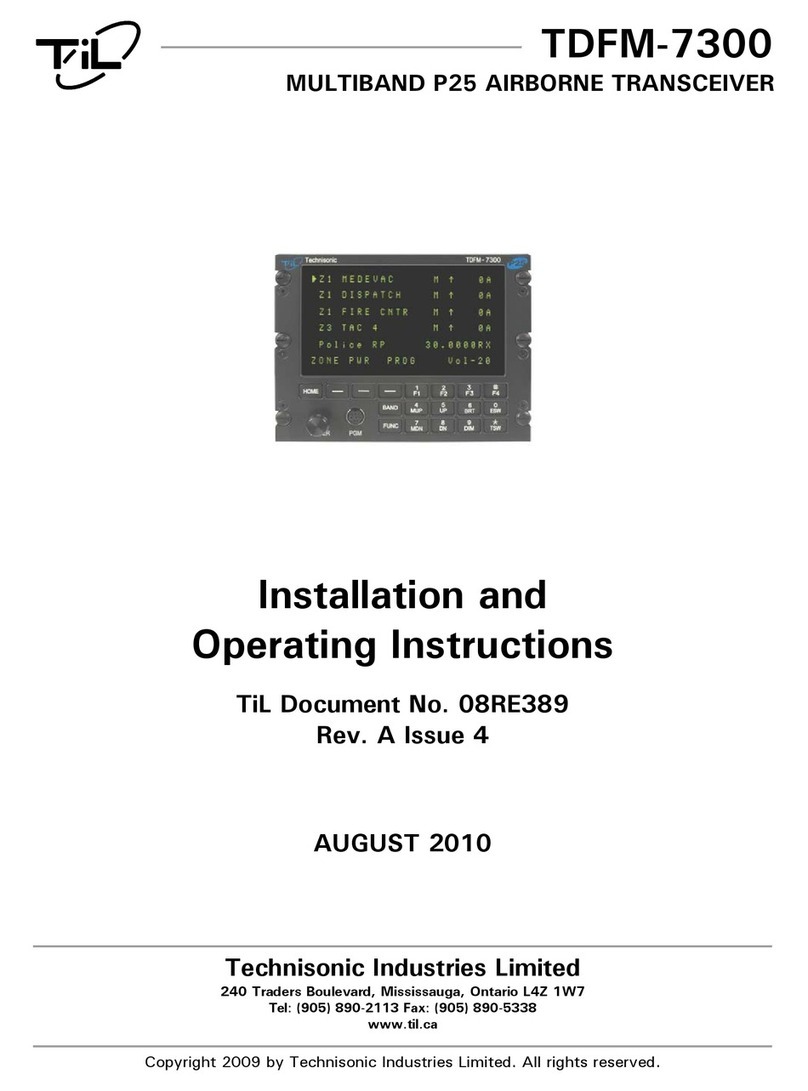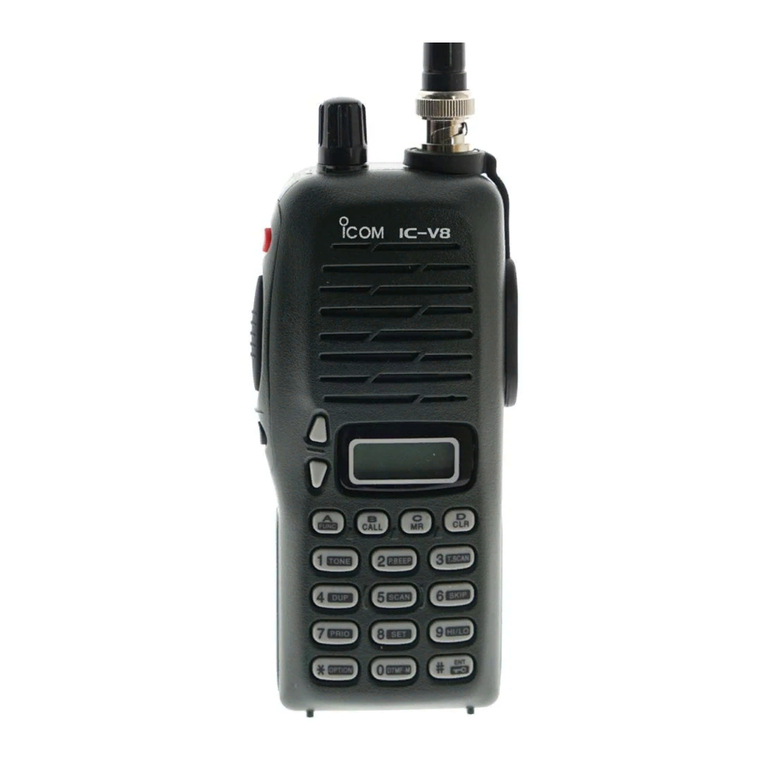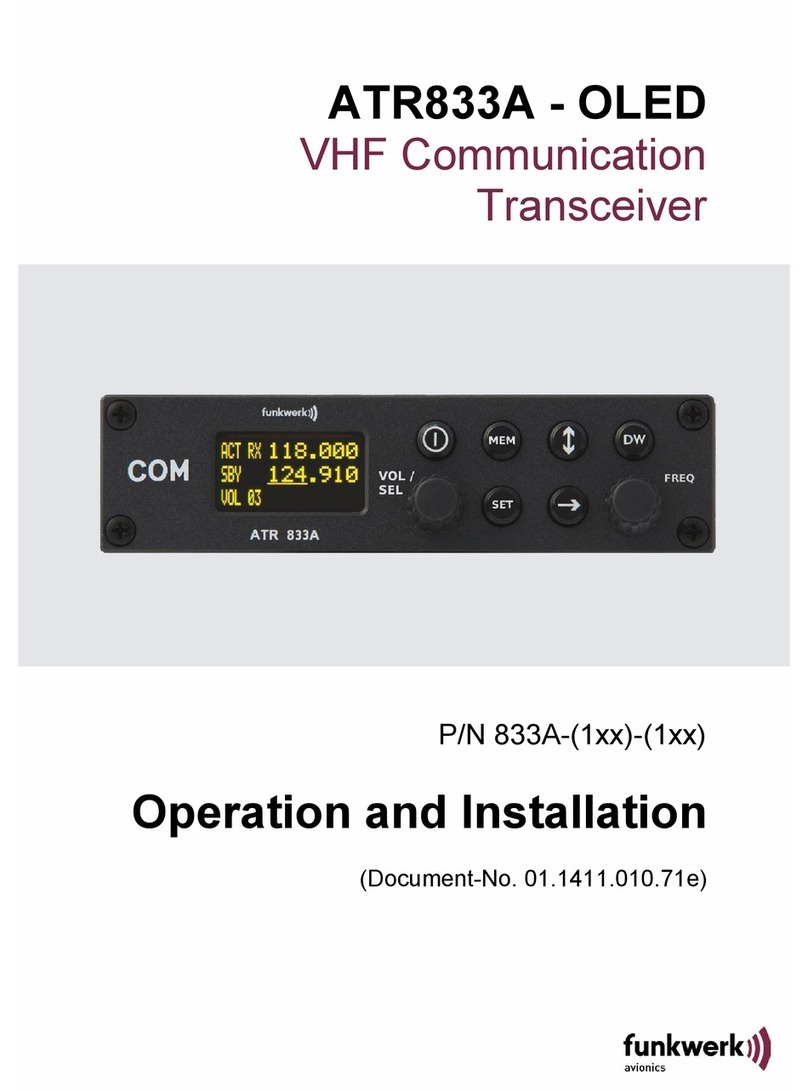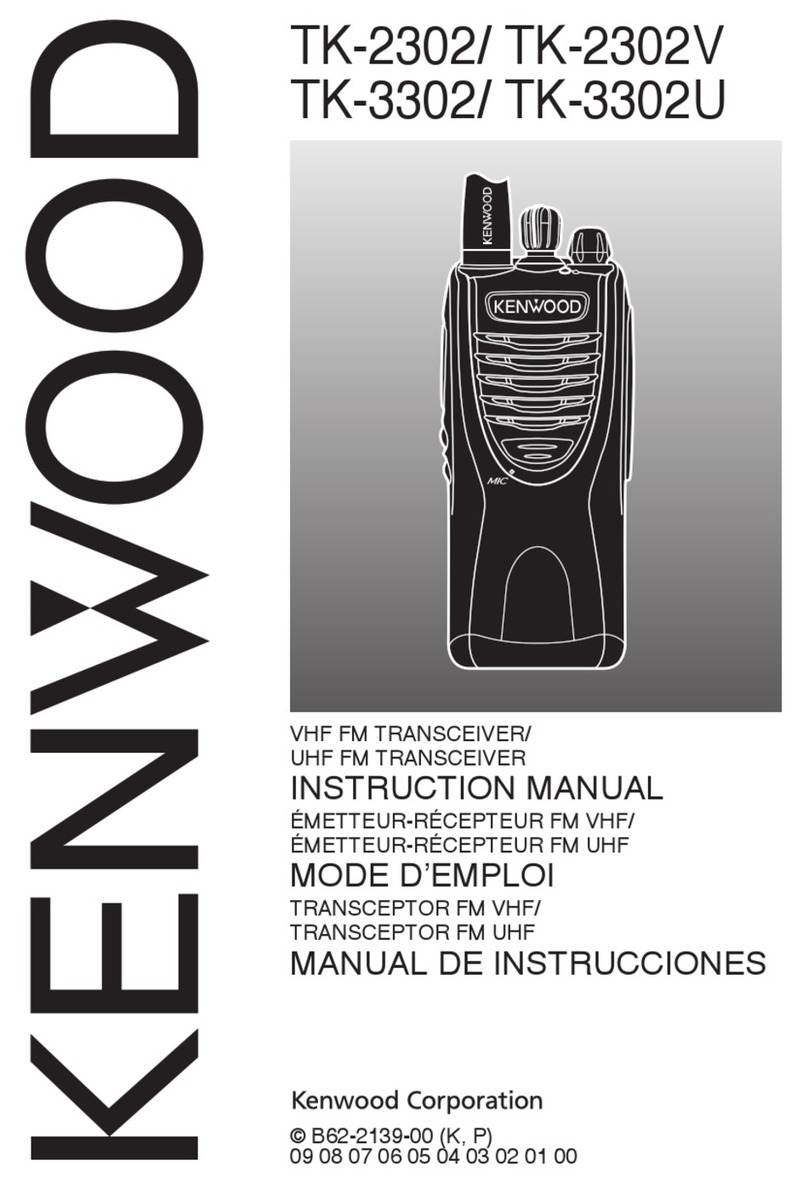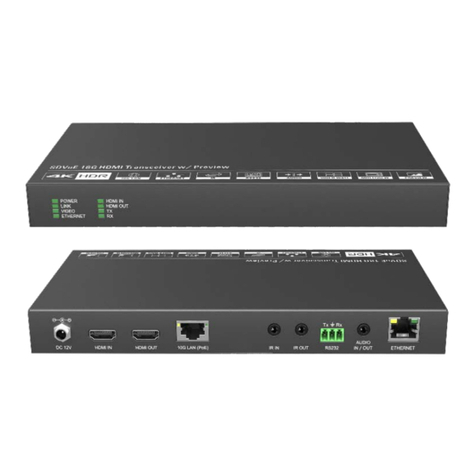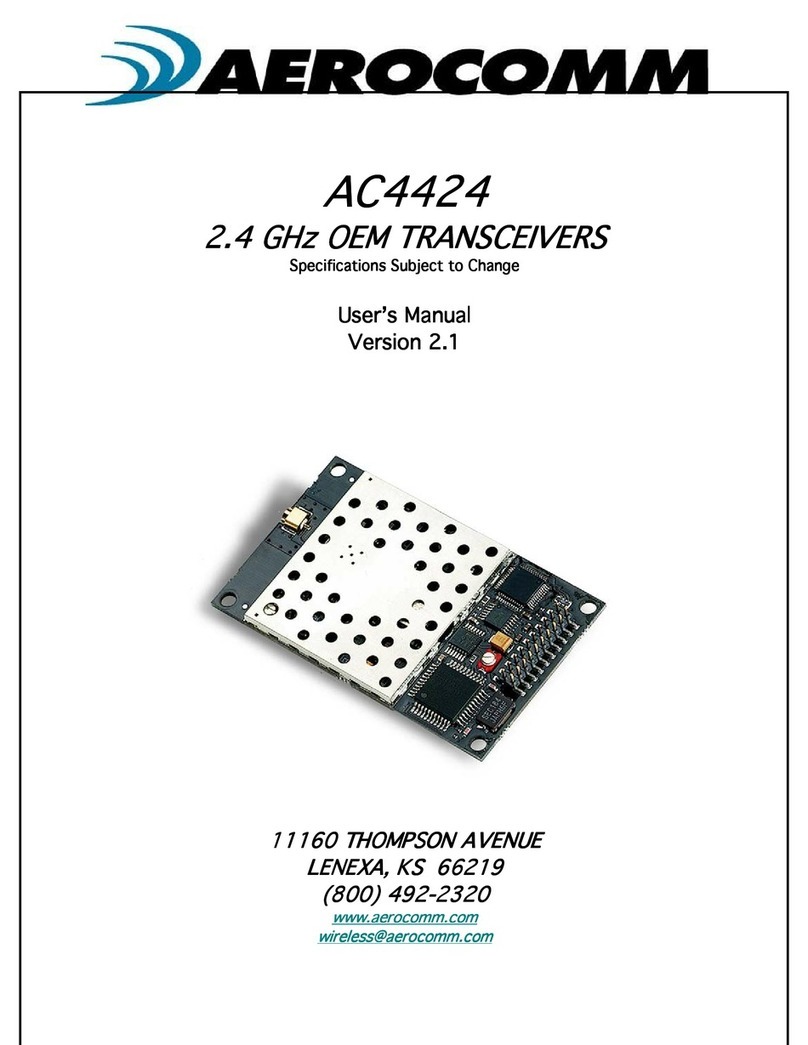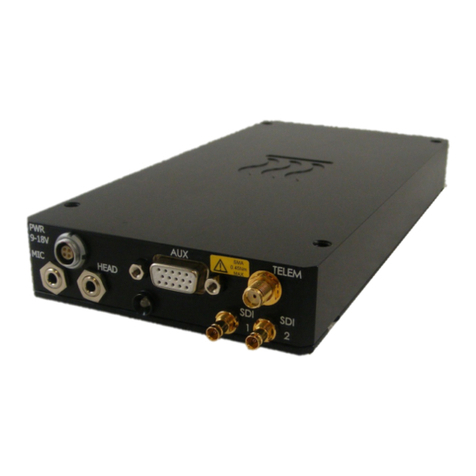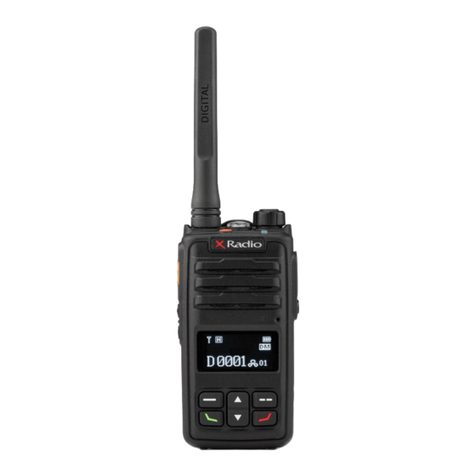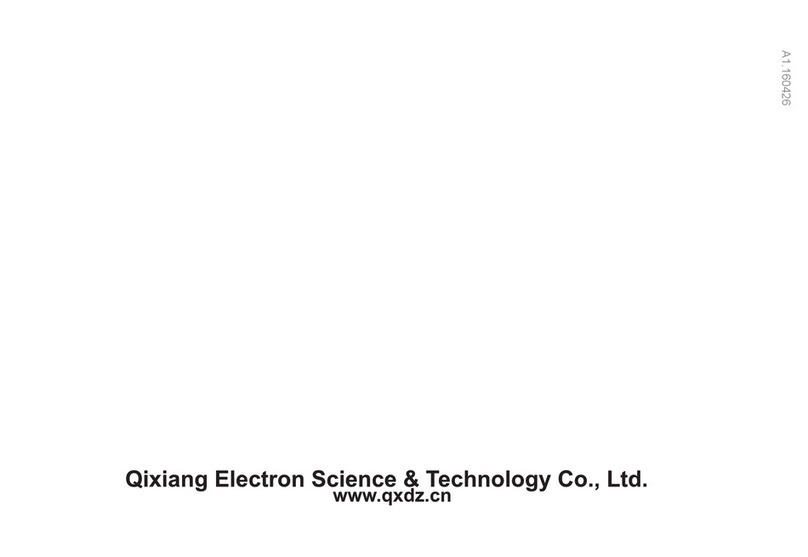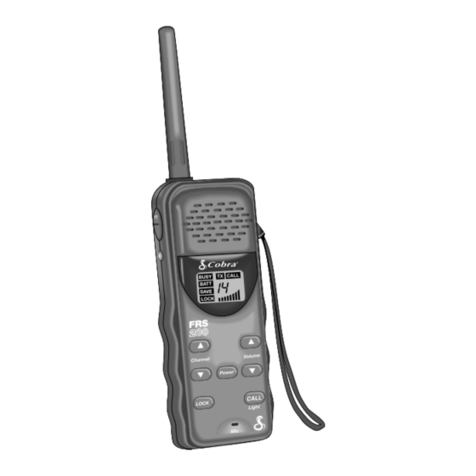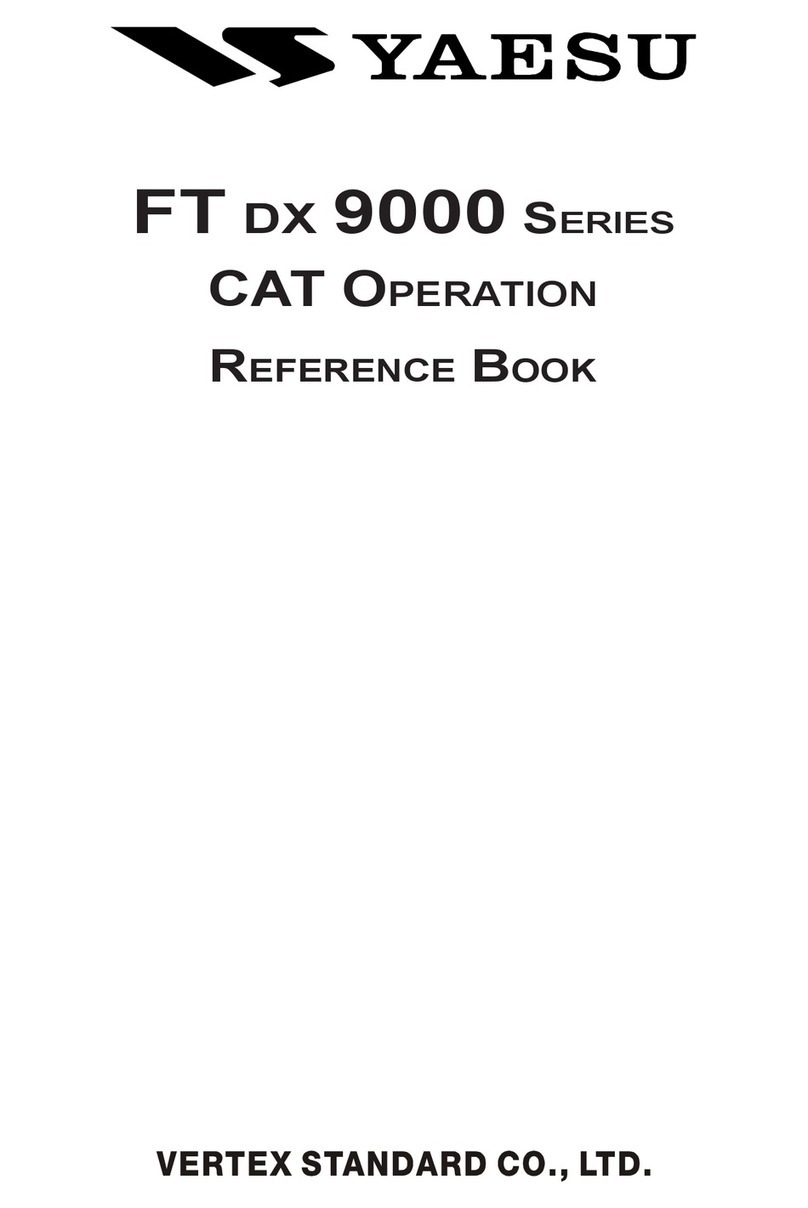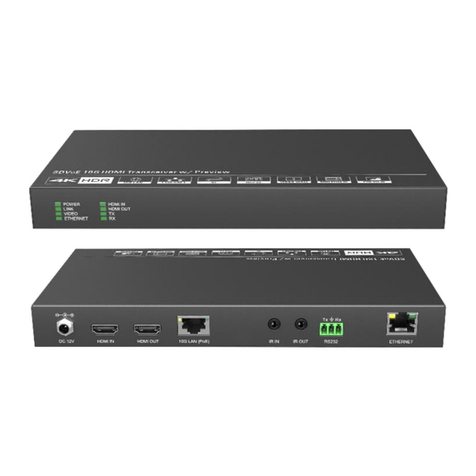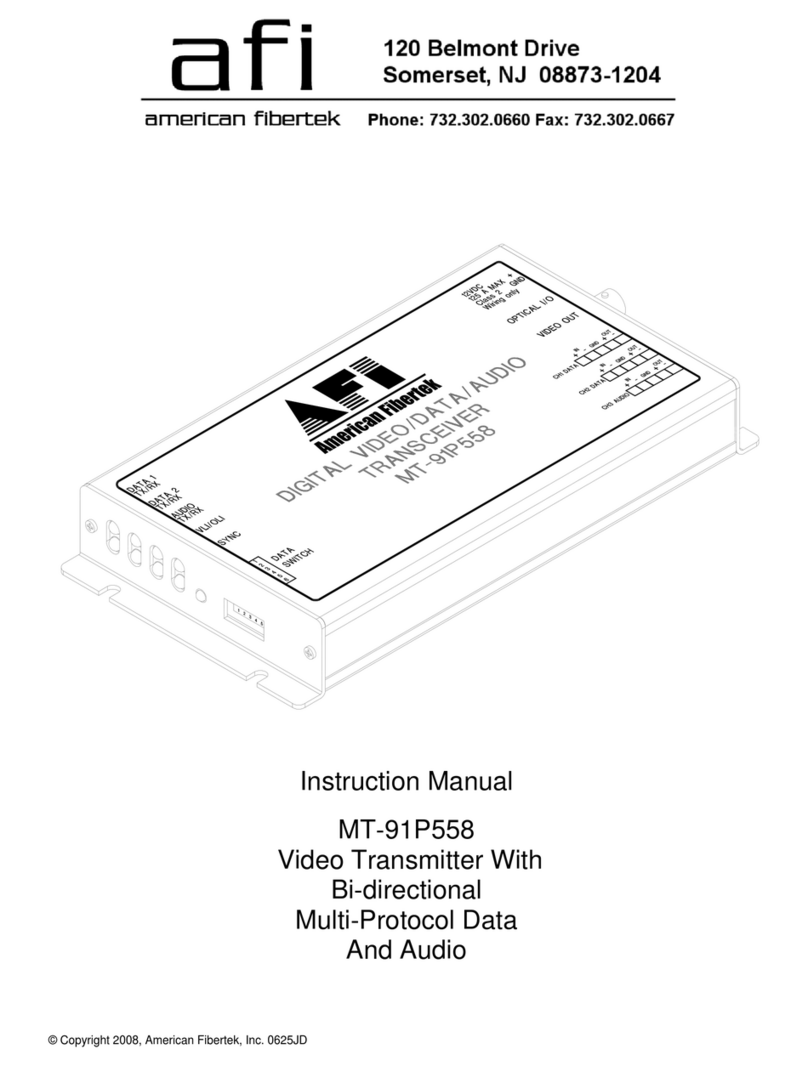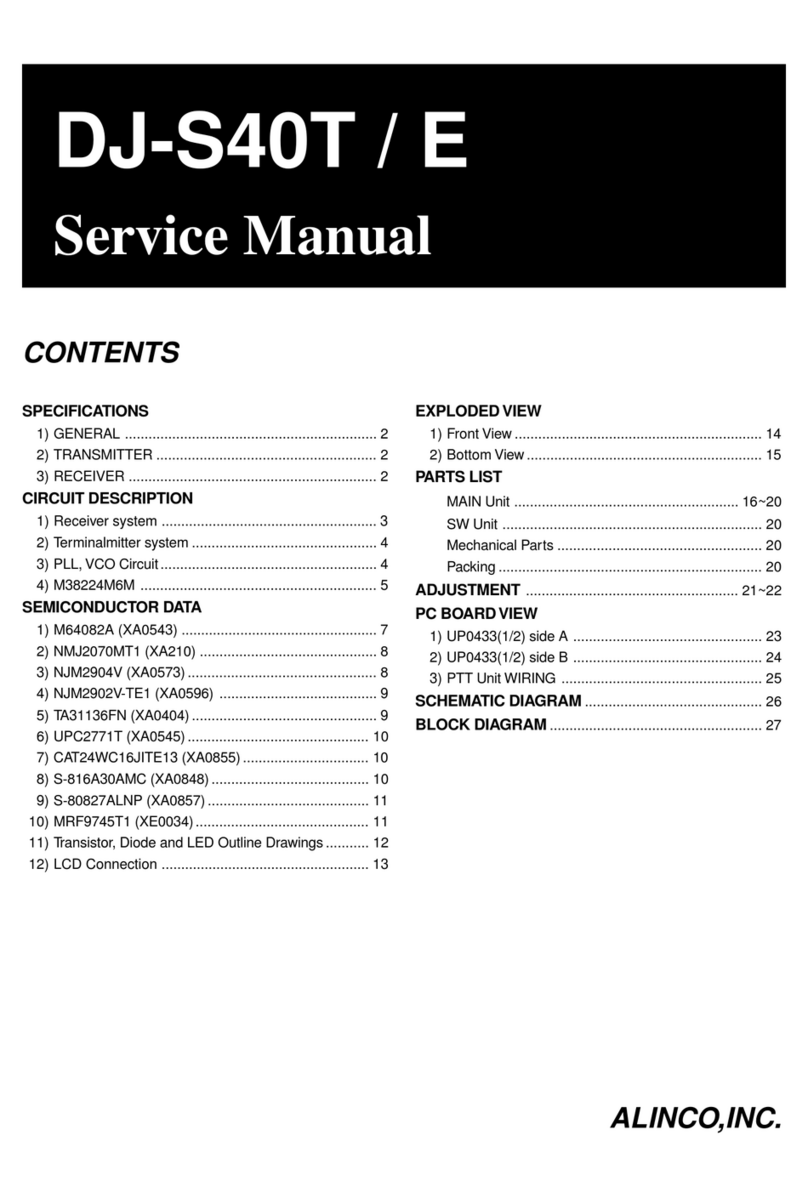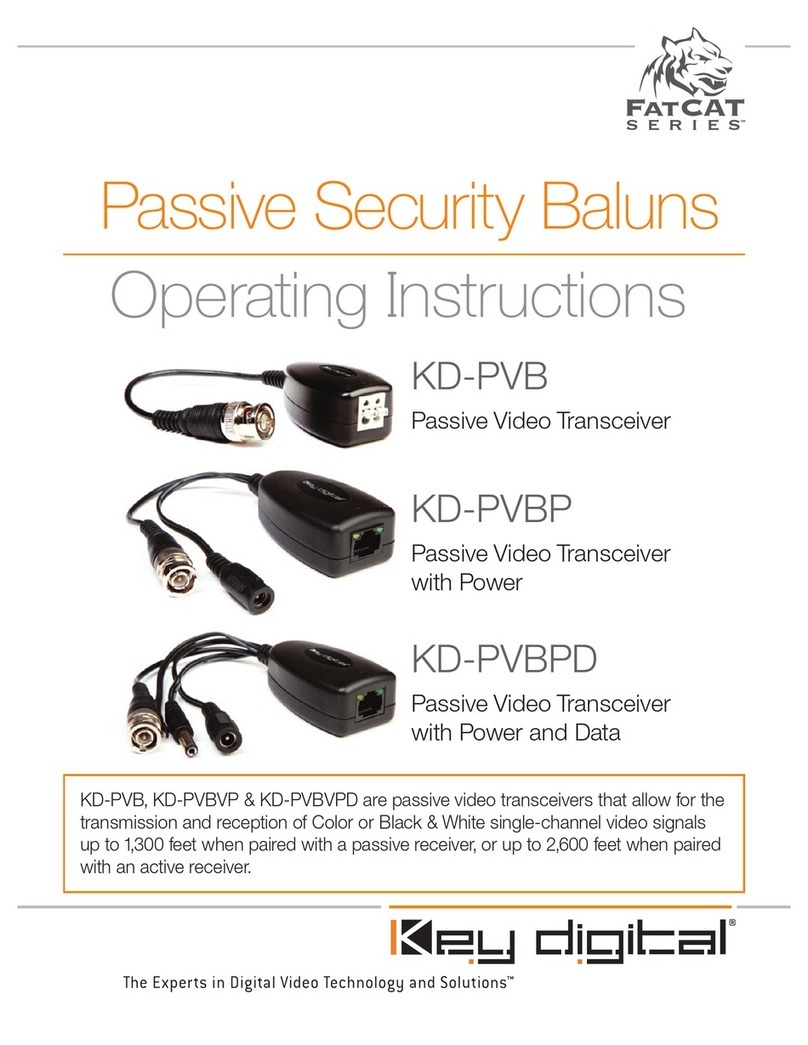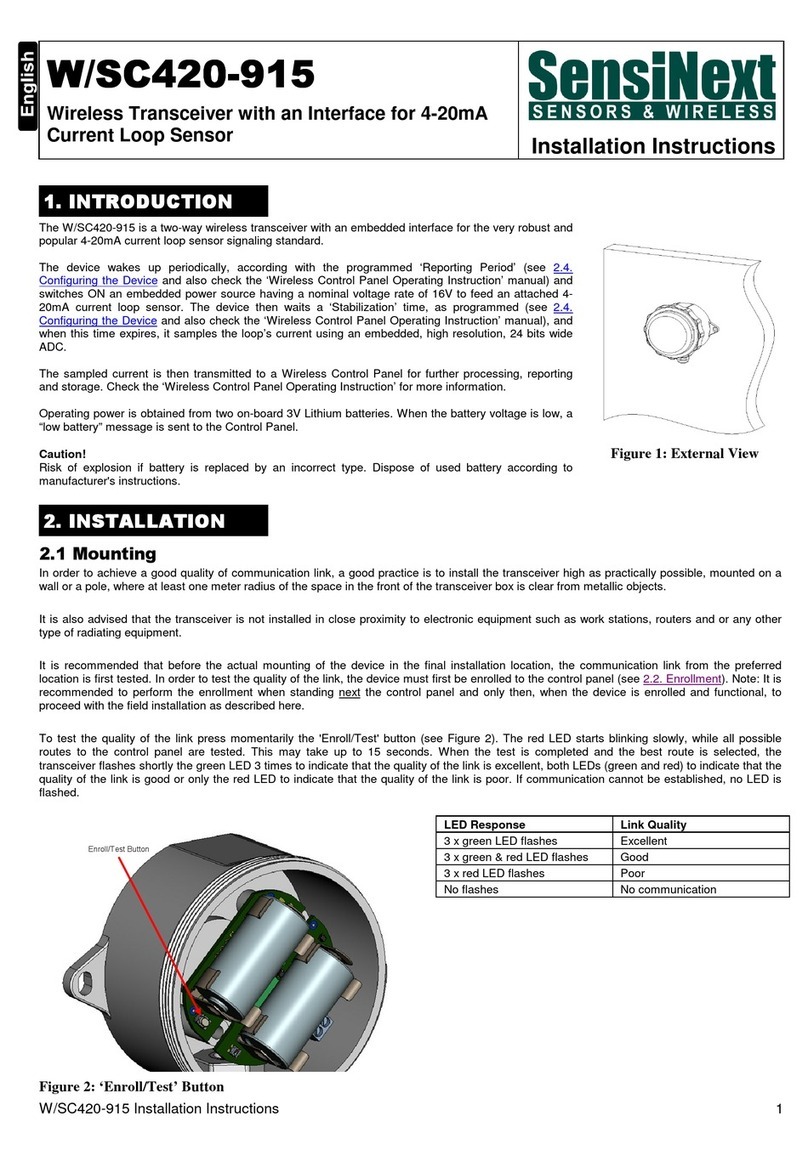TIL TDFM-9200 User manual

TDFM-9200
MULTIBAND P25 AIRBORNE TRANSCEIVER
Installation Instructions
TiL Document No. 13RE472
Rev. B
MAY 2014
Technisonic Industries Limited
240 Traders Boulevard, Mississauga, Ontario L4Z 1W7
Tel: (905) 890-2113 Fax: (905) 890-5338
www.til.ca
Copyright by Technisonic Industries Limited. All rights reserved.

TECHNISONIC INDUSTRIES LIMITED
TDFM-9200 Installation Instructions TiL 13RE472 Rev. B
ii
REVISION HISTORY
[ 13RE472 ]
REV SECTION
- PAGE - DESCRIPTION DATE EDITED BY
A iv Corrected DO-160 Information. July 2013 SM
B i Front Panel Image changed. May 24, 2014 AL
iv Minor change to Installation Approval Note.
1-2 Added Special Order Band Codes.
1-2 and 2-7
Specified “Section 2.17 Configuration Menu”
Refers to TDFM-9300 Operating Instructions.
2-1 P/N in Section 2.4 Corrected.
2-3
Added Antenna & Connector Locations as well
as Band Display Orientation.
2-9 to 2-13 Updated Figures 2.4 – 2.8.
All Changed Format for Section Headers.
All Corrected Spelling & Grammar throughout
document.

TECHNISONIC INDUSTRIES LIMITED
TDFM-9200 Installation Instructions TiL 13RE472 Rev. B
iii
ESD CAUTION
This unit contains static sensitive devices. Wear a grounded wrist strap and/or conductive gloves
when handling printed circuit boards.
FCC COMPLIANCE INFORMATION
This device complies with Part 15 of the FCC Rules. Operation is subject to the following two conditions:
(1) this device may not cause harmful interference and (2) this device must accept any interference
received, including interference that may cause undesired operation.
WARNING: For compliance with FCC RF Exposure Requirements, the mobile transmitter
antenna installation shall comply with the following two conditions:
1. The transmitter antenna gain shall not exceed 3 dBi.
2. The transmitter antenna is required to be located outside of a vehicle and kept at a separation distance of 70
cm or more between the transmitter antenna of this device and persons during operation.
NOTE: This equipment has been tested and found to comply with the limits for a Class A digital device,
pursuant to Part 15 of the FCC Rules. These limits are designed to provide reasonable protection against
harmful interference when the equipment is operated in a commercial environment. This equipment
generates, uses, and can radiate radio frequency energy and, if not installed and used in accordance with
the instruction manual, may cause harmful interference to radio communications. Operation of this
equipment in a residential area is likely to cause harmful interference, in which case the user will be
required to correct the interference at his/her own expense.
WARNING AND DISCLAIMER
Changes or modifications not expressly approved by Technisonic Industries could void the user’s
authority to operate the equipment.
This manual is designed to provide information about the TDFM-9200. Every effort has been made to
make this manual as complete and accurate as possible.
WARRANTY INFORMATION
The Model TDFM-9200 Transceiver is under warranty for one year from date of purchase. Failed units
caused by defective parts or workmanship should be returned to:
Technisonic Industries Limited
240 Traders Boulevard
Mississauga, Ontario L4Z 1W7
Tel: (905) 890-2113
Fax: (905) 890-5338
NOTES

TECHNISONIC INDUSTRIES LIMITED
TDFM-9200 Installation Instructions TiL 13RE472 Rev. B
iv
SUMMARY OF DO-160G ENVIRONMENTAL TESTING
Summary of DO-160G Environmental Testing for Technisonic Model TDFM-9200 Transceiver:
Conditions Category
Temperature and Altitude A2, B1, C4, D1
Temperature Variation B
Humidity A
Operational shock and Crash Safety A
Vibration S, U
Magnetic Effect Z
Power Input B
Voltage Spike B
Audio Frequency Susceptibility B
Induced Signal Susceptibility AC
Radio Frequency Susceptibility T
Radio Frequency Emission M
Electrostatic Discharge A
INSTALLATION APPROVAL NOTE
Presently, no TSO standard exists for airborne FM transceivers. To make it easier for installation
agencies to provide their customers with an approved installation supported by an effective Airworthiness
Approval, Technisonic has secured Supplemental Type Certificate (STC) approval. The above referenced
DO-160G test data is also on file and available from Technisonic to support approval requirements in
airframes for which Technisonic does not possess an STC.
Approved aircraft types are listed in the attachments to the formal STC documents. These STCs are the
exclusive property of Technisonic and require the written authority of Technisonic for their use. To assist
Factory Authorized Technisonic Dealers in the certification process, we have placed copies of our
Canadian and US STCs on our website along with a letter of authorization for their use. These documents
may be downloaded and used as support for the technical submission to FAA or Transport Canada. Only
authorized factory dealers/installers are permitted to download and make use of these documents on
behalf of their customers (end users) in support of regulatory agency approval. Please refer to the
Technisonic website www.til.ca for the latest issue of available STCs and letter of authorization for use.
Trademark Notices
TDFM-9200 Transceivers contain two-way radio protocols licensed from Motorola, Inc.
© 1997, 1998 Motorola, Inc.
Motorola KVL 3000+® is a registered trademark of Motorola.

TECHNISONIC INDUSTRIES LIMITED
TDFM-9200 Installation Instructions TiL 13RE472 Rev. B
v
SECTION TITLE PAGE
SECTION 1 GENERAL DESCRIPTION
1.1 INTRODUCTION ...................................................................................................................... 1-1
1.2 DESCRIPTION ......................................................................................................................... 1-1
1.3 MODEL VARIATION ................................................................................................................ 1-1
1.4 TECHNICAL CHARACTERISTICS .......................................................................................... 1-3
SECTION 2 INSTALLATION INSTRUCTIONS
2.1 GENERAL ................................................................................................................................ 2-1
2.2 EQUIPMENT PACKING LOG .................................................................................................. 2-1
2.3 INSTALLATION ........................................................................................................................ 2-1
2.4 INSTALLATION KIT – CONTENTS ......................................................................................... 2-1
2.5 ANTENNA INSTALLATION ..................................................................................................... 2-1
2.6 INSTALLATION – PIN LOCATIONS AND CONNECTIONS ................................................... 2-4
2.7 INSTALLATION – WIRING INSTRUCTIONS .......................................................................... 2-7
2.8 MAIN GROUND – J1 PINS 1 AND 14 ..................................................................................... 2-7
2.9 MAIN POWER + 28VDC – J1PINS 2 AND 15 ......................................................................... 2-7
2.10 MIC 1, 2, 3, 4, AND 5 – J1 PINS 3, 6, 9, J6 PIN 6, AND P1 PIN 15 ......................................... 2-7
2.11 MIC COMBINED 1 AND 2 – J6 PINS 7 AND 13 ...................................................................... 2-7
2.12 AUDIO 1, 2, 3, AND 4 – J1 PINS 4, 7, 10, J6 PIN 5, AND P1 PIN 6 ....................................... 2-7
2.13 AUDIO COMBINED 1 AND 2 – J6 PINS 2 AND 10 ................................................................. 2-7
2.14 PTT 1, 2, 3, 5, 6, AND 4 – J1 PINS 5, 8, 11, 21, 24, AND J6 PIN 3 ........................................ 2-8
2.15 PTT COMBINED 1 AND 2 – J6 PINS 4 AND 12....................................................................... 2-8
2.16 TX DATA AND RX DATA – J1 PINS 12 AND 13...................................................................... 2-8
2.17 UP AND DOWN – J1 PINS 16 AND 17 .................................................................................... 2-8
2.18 CHANNEL/BAND – J1 PIN 18 .................................................................................................. 2-8
2.19 PANEL BACKLIGHTING – J1 PIN 25....................................................................................... 2-8
2.20 SPEAKER LO AND HI – J6 PINS 8 AND 9............................................................................... 2-8
2.21 ANTENNA TUNER CONTROL LINES: P1 (PINS 1, 2, 3, 4, 5, 6, 10, AND 12) ....................... 2-8
2.22 ANTENNA SELECTION AND INSTALLATION CONSIDERATIONS....................................... 2-14
2.23 POST INSTALLATION EMI TEST ........................................................................................... 2-15
APPENDIX A Support Notes ................................................................................................................. 2-27
WARRANTY .......................................................................................................................................... 2-29
TABLE OF CONTENTS

TECHNISONIC INDUSTRIES LIMITED
TDFM-9200 Installation Instructions TiL 13RE472 Rev. B
vi
FIGURE TITLE PAGE
2.1 Outline Drawing ........................................................................................................................ 2-2
2.2 TDFM-9300 Antenna & Connector Locations .......................................................................... 2-3
2.3 TDFM-9300 Band Display Orientation ..................................................................................... 2-3
2.4 Wiring Connections for Individual Band Control with Separate Ground Returns...................... 2-9
2.5 Wiring Connections for Individual Band Control with a Single Ground Return ......................... 2-10
2.6 Wiring Connections for Combined Band Control with Separate Ground Returns..................... 2-11
2.7 Wiring Connections for Combined Band Control with a Single Ground Return ....................... 2-12
2.8 Wiring Connection Notes for the TDFM-9300 Transceiver ...................................................... 2-13
TABLE TITLE PAGE
2.1 J1 25 Pin D Connections .......................................................................................................... 2-3
2.2 J6 15 Pin High Density D Connections .................................................................................... 2-4
2.3 J5 15 Pin High Density D Connections .................................................................................... 2-4
LIST OF FIGURES
LIST OF TABLES

TECHNISONIC INDUSTRIES LIMITED
TDFM-9200 Installation Instructions TiL 13RE472 Rev. B
1-1
1.1 INTRODUCTION
This publication provides operating information on the TDFM-9200 airborne transceiver. The
exact configuration depends on which and how many RF modules are installed.
1.2 DESCRIPTION
The TDFM-9200 transceiver is an airborne multi-band radio capable of operation in conventional
analog and P25 digital FM systems, SmartNet/SmartZone trunking systems, and P25 9600
trunking systems. RF modules are available in single or dual bands that support VHF, UHF-LO,
UHF-HI, and 700-800 MHz bands. Up to 5 single or dual band modules can be supported.
These optional additional features include P25 9600 trunking Phase 1 and 2 that may be
combined with AES and/or DES-OFB encryption with OTAR in any of the available modules.
Bands 1 and 2 on the TDFM-9200 is not normally frequency agile. In order to have the ability to
change the frequencies at the front panel, the FPP (front panel programming) option must be
ordered for each band. FPP is only available on the VHF and UHF modules.
The TDFM-9200 has provisions for two of the above RF modules as well as two analog only
modules. These additional modules are fully frequency programmable from the associated front
panel. Analog only modules support CTCSS, DCS, wide, and narrow band operation where
applicable.
1.3 MODEL VARIATION
There are several variations of the Model TDFM-9200 Transceiver. Each variation offers different
features and performance based on the type of RF modules and options installed.
Rf Modules are mounded in trays of two with up to 3 trays supported.
The following is a breakdown of the TDFM-9200 model variations:
P/N 101263-D-90-TBB-TBB-TBB-P9XXXX
(PRODUCT TYPE)-(D)-(9X)-(Tray 1)-(Tray2)-(Tray3)-(Project)
PRODUCT TYPE: 101263 = TDFM 9200 series, 3 trays, 2 – 6 modules
D= Display type:
1) Color TFT
2) Standard Green/NV
9X = TDFM-9200 series variant:
92 = TDFM-9200
SECTION 1: GENERAL DESCRIPTION

TECHNISONIC INDUSTRIES LIMITED
TDFM-9200 Installation Instructions TiL 13RE472 Rev. B
1-2
Tray Breakdown: (TBB):
T= Module type: A= T30xx RF modules (Single or Dual)
B is Band code for each module in the tray.
Band Codes
Band numbers indicate single band modules and letters indicate dual band modules.
Project Number: P9XXXX represents a 5 digit project number that identifies specific options that
are contained in each module and describes the full TDFM-9200 configuration.
All model variations are capable of supporting both 28 Volt and 5 Volt AC or DC back lighting.
The units are shipped set to operate on 28 Volt back lighting. Equipment can be set to operate on
5V back lighting by using the software based configuration menu. See Section 2.17 Configuration
Menu in the TDFM-9200 Operating Instructions manual available at www.til.ca. Damage will not
occur if the incorrect voltage is applied.
1 VHF (136-174)
2 UHF LO (380-470)
3 UHF HI (450-520)
4 700/800 (764-870)
A V/700/800
B V/ UHF LO
C V/ UHF HI
D UL/UH
E UL/700/800
F UH/700/800

TECHNISONIC INDUSTRIES LIMITED
TDFM-9200 Installation Instructions TiL 13RE472 Rev. B
1-3
1.4 TECHNICAL CHARACTERISTICS
Specification Characteristic
Model Designation: TDFM-9200
Physical Dimensions: Approx. (L) 8.0" x (W) 5.75" x (H) 4.5"
Weight: ~7.0 Lbs (3.2 Kg)
Operating Temperature Range: -30° C to +60° C
Power Requirement:
Voltage:
Current:
28.0 VDC ± 15%
500 mA minimum / 7.5A maximum
Audio Output Power (including sidetone): 65 mW into 600
Ω
Microphone Inputs: Carbon or Equivalent
Panel Back Lighting:
Voltage:
Current:
28 or 5 Volts AC or DC (selectable)
10 uA
RF Modules
Specification Characteristic
RF Output Power: 1 or 6 Watts (VHF)
1 or 5 Watts (UHF)
1 or 3 Watts (700/800)
Frequency Range
VHF Band:
UHF LO Band:
UHF HI Band:
700 / 800 Bands:
136 to 174 MHz
380 to 470 MHz
450 to 520 MHz
764 to 870 MHz
No. of channels per band: 2000 pre-programmable channels
Transmitter section VHF UHF 800
FM Hum and noise in dB (wideband):
Audio Distortion:
Frequency Stability in ppm:
Modulation Limiting:
-48 -45 -45
1% 1.0% 1.0%
± 1.0 ± 1.0 ± 1.5
Wide band ± 5 kHz
Narrow band ± 2.5 kHz
Receiver section VHF UHF 800
Sensitivity in uV:
* Digital 1% BER (12.5 kHz)
* Digital 5% BER (12.5 kHz)
** Analog with 12 dB SINAD
0.29 0.32 0.40
0.21 0.28 0.30
0.25 0.25 0.25
Selectivity in dB:
25 kHz Channel
12.5 kHz Channel
Intermodulation * **
-80 -78 -72
-70 -68 -67
-80 -80 -80
* Measured in digital mode per TIA / EIA IS 102.CAAA under nominal conditions.
** Measured in analog mode per TIA / EIA 603 under nominal conditions.

TECHNISONIC INDUSTRIES LIMITED
TDFM-9200 Installation Instructions TiL 13RE472 Rev. B
1-4
ANALOG MODULE SPECIFICATIONS
GENERAL
Frequency Ranges:
VHF FM Lo module
VHF FM High module
UHF FM module
VHF FM Lo 2 module
VHF AM module
UHF AM module
30 - 50 MHz
136 - 174 MHz
403 - 512 MHz
66 - 88 MHz
118 - 138 MHz
225 - 400 MHz
Operating Mode: F3E simplex or semi-duplex (FM modules)
A3E simplex (AM modules)
Channel Spacing: 25 or 12.5 kHz (25 kHz only for AM)
FM Frequency Selection:
via front panel
200 memories per band programmed with:
a) TX Frequency/RX Frequency
b) TX/RX CTCSS tone or DPL code
c) 9-character alphanumeric title
CTCSS squelch/encoder: * All CTCSS tones available (FM modules only)
DPL digital squelch/encoder: * All standard DPL codes (FM modules only)
DTMF encoder: All standard DTMF tones
* Available only on FM Modules.
VHF FM RECEIVER
Sensitivity at 12 dB SINAD Better than 0.35 µV
Adjacent Channel Selectivity -75 dB (25 kHz)
-70 dB (12.5 kHz)
Spurious Attenuation -90 dB
Third Order Intermodulation -70 dB
Image Attenuation -80 dB
FM Acceptance ± 6 kHz
Hum and Noise Better than 45 dB
Audio Distortion Less than 5%
Antenna Conducted Emission Less than -70 dBm
UHF FM RECEIVER
Sensitivity at 12 dB SINAD Better than 0.35 µV
Adjacent Channel Selectivity -70 dB (25 kHz)
-60 dB (12.5 kHz)
Spurious Attenuation -80 dB
Third Order Intermodulation -70 dB
Image Attenuation -60 dB
FM Acceptance ± 6 kHz
Hum and Noise Better than 40 dB
Audio Distortion Less than 5%
Antenna Conducted Emission Less than -70 dBm

TECHNISONIC INDUSTRIES LIMITED
TDFM-9200 Installation Instructions TiL 13RE472 Rev. B
1-5
VHF LO and VHF LO 2 FM RECEIVER
All specifications identical to VHF receiver
VHF, VHF LO, VHF LO 2 and UHF FM TRANSMITTER
RF Power Output 1 watt or 10 watts
Output Impedance 50 ohms
Maximum Deviation ± 5 kHz (25 kHz mode)
(In narrowband mode) ± 2.5 kHz (12.5 kHz mode)
Spurious Attenuation -90 dB below carrier level
Frequency Stability ± 2.5 ppm
Harmonic Attenuation -60 dB below carrier level
FM Hum And Noise -40 dB
Audio Input 50 mV at 2.5 kHz into
200 ohms input circuit for
± 3.5 kHz deviation, adjust.
Audio Distortion Less than 5%
VHF AM RECEIVER
Sensitivity at 12 dB SINAD Better than 2.0 µV
Adjacent Channel Selectivity -70 dB (25 kHz)
Spurious Attenuation -70 dB
Third Order Intermodulation -70 dB
Image Attenuation -60 dB
Hum and Noise Better than 40 dB
Audio Distortion Less than 5%
Antenna Conducted Emission Less than -70 dBm
VHF AM TRANSMITTER
RF Power Output 5 watts (2.5 watts carrier)
Output Impedance 50 ohms
Maximum Modulation (max) 95%
Maximum Modulation (min) 75%
Spurious Attenuation -60 dB below carrier level
Frequency Stability ± 2.5 ppm
Harmonic Attenuation -60 dB below carrier level
Signal to Noise Ratio -35 dB
Audio Input 50 mV at 2.5 kHz into
200 ohm input circuit for
30% modulation (adjustable)
Audio Distortion Less than 5%

TECHNISONIC INDUSTRIES LIMITED
TDFM-9200 Installation Instructions TiL 13RE472 Rev. B
1-6
This page left intentionally blank

TECHNISONIC INDUSTRIES LIMITED
TDFM-9200 Installation Instructions TiL 13RE472 Rev. B
2-1
2.1 GENERAL
This section contains information and instructions for the correct installation of the TDFM-9200
Transceiver.
2.2 EQUIPMENT PACKING LOG
Unpack the equipment and check for any damage that may have occurred during transit. Save
the original shipping container for returns due to damage or warranty claims. Check that each
item on the packing slip has been shipped in the container.
2.3 INSTALLATION
The TDFM-9200 Transceiver is designed to be Dzus mounted and should be installed in
conjunction with an IN-9300 installation kit. See Figure 2.1 for an outline drawing of the unit with
dimensions to facilitate the installation.
2.4 INSTALLATION KIT – CONTENTS
The IN-9300 installation kit (P/N 129292) consists of:
1. One 25 Pin Cannon D mating connector (female) complete with crimp pins and hood.
2. Three 15 Pin HD Cannon D mating connector (female) complete with crimp pins and hood.
3. One 15 Pin HD Cannon D mating connector (male) complete with crimp pins and hood.
4. 4 BNC connectors.
2.5 ANTENNA INSTALLATION
The type and number of antennas depends on the model of transceiver being installed. The
following is a list of recommended antennas for the various RF modules:
VHFLO 30 to 50 MHz Foxtronics Part # FLX-3050B or
Sensor Systems Part # S65-8282-34*
VHF AM 118 to 138 MHz Comant Part # CI-292-1
VHF 136 to 174 MHz Comant Part # CI-292-3
UHFLO 403 to 470 MHz Comant Part # CI-275
UHFHI 450 to 520 MHz Comant Part # CI-285
800 800 to 870 MHz Comant Part # CI-306
800/700 764 to 870 MHz Comant Part # CI-285
The antenna should be mounted on the bottom of the aircraft whenever possible. Consult with
instructions provided with the antenna. Connect the RF cables to the back of the transceiver
using the MALE BNC connectors provided in the installation kit. It is possible to use equivalent 50
ohm aviation antennas that cover the appropriate bandwidths.
SECTION 2: INSTALLATION INSTRUCTIONS

TECHNISONIC INDUSTRIES LIMITED
TDFM-9200 Installation Instructions TiL 13RE472 Rev. B
2-2
FIGURE 2.1 Outline Drawing for Model TDFM-9200

TECHNISONIC INDUSTRIES LIMITED
TDFM-9200 Installation Instructions TiL 13RE472 Rev. B
2-3
FIGURE 2.2 TDFM-9200 Antenna & Connector Locations
FIGURE 2.3 TDFM-9200 Band Display Orientation
BANDS
1
2
3
5
ANT 5 – VLO,
VAM OR UAM
P1
ANT 1 ANT 2
J1 J5 J6
ANT 3 – VLO,
VAM OR UAM
P2

TECHNISONIC INDUSTRIES LIMITED
TDFM-9200 Installation Instructions TiL 13RE472 Rev. B
2-4
2.6 INSTALLATION – PIN LOCATIONS AND CONNECTIONS
J1 (25 Pin D Connections) - Use FEMALE Connector
Pin # Description
1 Ground
2 Main Power +28 VDC
3 Mic 1
4 Audio 1
5 PTT 1
6 Mic 2
7 Audio 2
8 PTT 2
9 Mic 3
10 Audio 3
11 PTT 3
12 TX Data
13 RX Data
14 Ground
15 Main Power +28 VDC
16 Up
17 Down
18 Channel / Band
19 Mic 5
20 Audio 5
21 PTT 5
22 Mic 6
23 Audio 6
24 PTT 6
25 Panel Backlighting
TABLE 2.1 J1 (25 Pin D) Connections

TECHNISONIC INDUSTRIES LIMITED
TDFM-9200 Installation Instructions TiL 13RE472 Rev. B
2-5
J6 (15 Pin High Density D Connections) – Use FEMALE Connector
Pin # Description
1 Ground
2 Audio Combined 1
3 PTT4
4 PTT Combined 1
5 Audio 4
6 Mic 4
7 Mic Combined 1
8 Speaker Lo
9 Speaker Hi
10 Audio Combined 2
11 Misc In
12 PTT Combined 2
13 Mic Combined 2
14 Misc In/Out
15 Audio Combined Ground 2
TABLE 2.2 J6 (15 Pin HDD) Connections
J5 (15 Pin High Density D Connections) – Use MALE Connector
Pin # Description
1 Audio 2
2 Audio 5
3 Audio 6
4 Audio 3
5 Audio 4
6 Audio Ground 2
7 Audio Ground 5
8 Audio Ground 6
9 Audio Ground 3
10 Audio Ground 4
11 Audio 1
12 Audio Ground 1
13 Ground
14 Audio Combined Ground 1
15 Audio Combined 1
TABLE 2.3 J5 (15 Pin HDD) Connections

TECHNISONIC INDUSTRIES LIMITED
TDFM-9200 Installation Instructions TiL 13RE472 Rev. B
2-6
P1 Connections
(15 Pin [High Density] FEMALE D Connector)
Pin # Description
1 Band 3 - 4 MHz
2 Band 3 - 8 MHz
3 Band 3 - 10 MHz
4 Band 3 - 20 MHz
5 Band 3 - 40 MHz
6 Audio 3
7 No connection
8 No connection
9 No connection
10 Band 3 - Tune Indicator
11 Speaker 3
12 Band 3 - Tune Enable
13 Ground
14 PTT3
15 Mic 3
TABLE 2.4 Wire Connections on a 15 Pin [High-Density] FEMALE D Connector
P2 Connections
(15 Pin [High Density] FEMALE D Connector)
Pin # Description
1 Band 5 - 4 MHz
2 Band 5 - 8 MHz
3 Band 5 - 10 MHz
4 Band 5 - 20 MHz
5 Band 5 - 40 MHz
6 Audio 5
7 No connection
8 No connection
9 No connection
10 Band 5 - Tune Indicator
11 Speaker 5
12 Band 5 - Tune Enable
13 Ground
14 PTT5
15 Mic 5
TABLE 2.4 Wire Connections on a 15 Pin [High-Density] FEMALE D Connector

TECHNISONIC INDUSTRIES LIMITED
TDFM-9200 Installation Instructions TiL 13RE472 Rev. B
2-7
2.7 INSTALLATION – WIRING INSTRUCTIONS
Figure 2-2(a, b, and c) show all required connections and recommended wire sizes for the TDFM-
9200 transceiver. The TDFM-9200 allows for either a single audio output ground or separate
grounds for each audio output. If a single point ground is required for a pre-existing installation,
the dongle supplied in the installation kit must be plugged into J5. If this is a new installation, it is
recommended to use the isolated ground returns to the audio panel for reduced cross talk
between bands and airframe noise. The audio panel must have isolated grounds for each audio
input (such as Technisonic’s A710, A711, A711L, and TDAP-711) to take advantage of this
feature. There are receive audio, mic audio, and Push To Talk (PTT) lines for each band as well
as two sets of lines combining all six bands. The TDFM-9200 can be wired such that band
selection can be made on the audio panel. Up to 6 positions need to be available on the audio
panel; otherwise, the TDFM-9200 can be wired into one or two positions of the audio panel where
band selection and audio monitoring is done on the TDFM-9200 front panel. An installation can
be wired in a combination of both methods since all inputs and outputs are always active.
2.8 MAIN GROUND – J1 PINS 1 AND 14
Both pins should be connected to power ground. These pins are internally connected to the
chassis.
2.9 MAIN POWER + 28VDC – J1 PINS 2 AND 15
Both pins should be connected to +28 volts DC +/- 15%.
2.10 MIC 1, 2, 3, 4, AND 5 – J1 PINS 3, 6, 9, J6 PIN 6, AND P1 PIN 15
The microphone input signals shall be connected using shielded wire with the shield connected to
ground (pin 1 or 14). It is recommended for best results to leave the other end of the shield
floating to prevent ground currents unless you are connecting to an audio panel with floating hi
and lo inputs (like the Technisonic A710, A711, A711L, or TDAP-711) in which case the shield
must be connected to the lo input. These are individual inputs for each band.
2.11 MIC COMBINED 1 AND 2 – J6 PINS 7 AND 13
The combined mic inputs should be wired and shielded as the individual mic inputs above. These
mic inputs that can be used for any band. Band selection is made at the TDFM-9200 front panel.
2.12 AUDIO 1, 2, 3, 4 – J1 PINS 4, 7, 10, J6 PIN 5, AND P1 PIN 6
These are individual audio outputs from each band. All outputs are 600 ohms impedance. The
output power is 65 mW maximum. Unused outputs do not have to be terminated and should be
left unconnected. These outputs are also found on J5 along with their respective grounds such
that a separate wire bundle can be run with only audio outputs, further reducing the possibility of
cross talk.
2.13 AUDIO COMBINED 1 AND 2 – J6 PINS 2 AND 10
These are combined audio outputs from all bands as selected from the front panel. The
specifications are the same as the individual outputs above.

TECHNISONIC INDUSTRIES LIMITED
TDFM-9200 Installation Instructions TiL 13RE472 Rev. B
2-8
2.14 PTT 1, 2, 3, 5, 6, AND 4 – J1 PINS 5, 8, 11, 21, 24, AND J6 PIN 3
There are individual PTT lines for each band. These lines should be floating when in receive and
grounded for transmit. The input has a pull up resistor to 5 volts. Connecting an audio panel that
wishes to see more may result in no receive audio. Connect a 1N4006 diode in series with the
cathode towards the audio panel in this case.
2.15 PTT COMBINED 1 AND 2 – J6 PINS 4 AND 12
These are combined PTT inputs to all bands as selected from the front panel. The specifications
are the same as the individual inputs above.
2.16 TX DATA AND RX DATA – J1 PINS 12 AND 13
These pins provide RS-232 serial communications for use with the RC-9000 remote control head
if installed. Consult the RC-9000 installation manual for details.
2.17 UP AND DOWN – J1 PINS 16 AND 17
These pins can be used to scroll up and down through the bands or channels for the band
currently selected depending on the band input below. The inputs normally floating are grounded
to activate. Two push buttons or a center off, SPDT, spring-loaded toggle switch are typically
used on these inputs.
2.18 CHANNEL/BAND – J1 PIN 18
The Channel / Band input determines the function of the up down inputs above. If left
unconnected, the inputs are for channel selection. If grounded, the input is for band selection.
2.19 PANEL BACKLIGHTING – J1 PIN 25
Connect to aircraft panel dimming bus. The transceiver is capable of supporting 28 VAC/DC or 5
VAC/DC backlighting circuits. Select 28 volts or 5 volts via the configuration menu (see Section
2.17 in the TDFM-9200 Operating Instructions manual). No damage will occur if the wrong setting
is made.
2.20 SPEAKER LO AND HI – J6 PINS 8 AND 9
Not normally connected in the aircraft. This output is 4 / 8 ohms at 1.1 watts max and has the
audio associated with Audio Combined 1. This output does not have to be terminated when not
used and should be left unconnected.
2.21 ANTENNA TUNER CONTROL LINES:
P1 (PINS 1, 2, 3, 4, 5, 6, 10, AND 12)
These connections are to control an antenna tuner system such as the Foxtronics FLX-3050B.
Connect according to the manufacturer’s instructions. In the case of the FLX-3050B, the tune
indicator (which is normally connected to a light) can be connected to pin 10 so that the tuning
indication will show on the TDFM-9200 display. If a passive antenna is used, these lines shall
remain unconnected.
Table of contents
Other TIL Transceiver manuals
